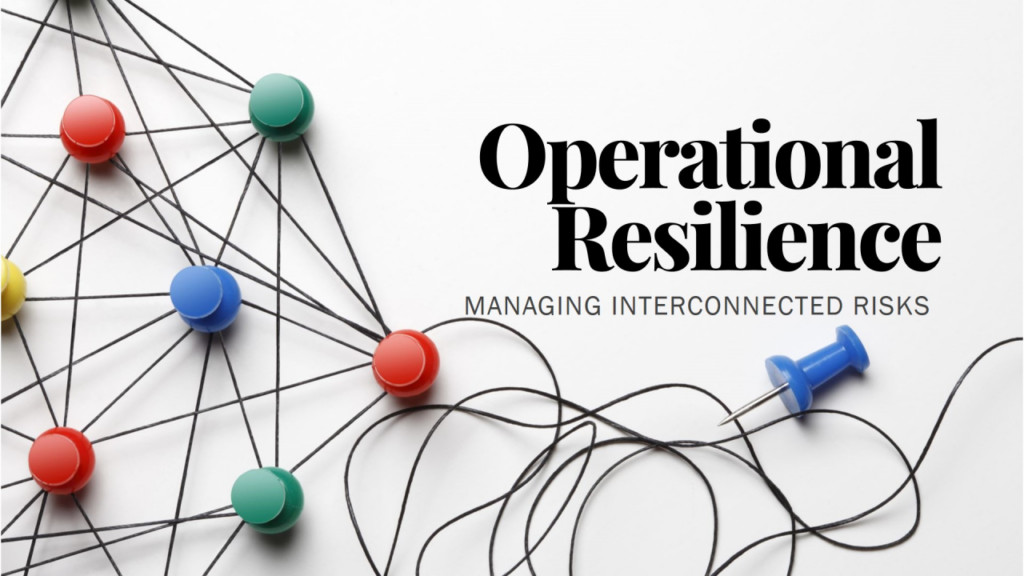In today’s rapidly changing world, businesses are no longer dealing with one risk at a time. Instead, they face a complex web of interconnected threats. Consider this: a cyber attack can lead to a data breach, which might cause regulatory fines, reputational damage, and even halt operations. Or imagine a natural disaster disrupting supply chains, affecting production schedules and leading to revenue losses. Risks today are more intertwined than ever, and a single event can trigger a cascade of negative effects across an organization.
So, how do you prepare for such complexity? The answer lies in operational resilience. Let’s break down what operational resilience means, why it’s crucial, and how it can become your organization’s secret weapon against the chaos of interconnected risks.
What is Operational Resilience?
Operational resilience is all about being ready for the unexpected. It’s the capability of an organization to continue delivering essential services, regardless of the disruptions it faces. Whether it’s a cyber attack, a pandemic, a supply chain disruption, or a regulatory shift, operational resilience ensures that your business can not only withstand these shocks but also recover quickly and continue to operate effectively.
Unlike traditional risk management, which often focuses on identifying and mitigating specific risks, operational resilience takes a broader perspective. It’s not just about preventing incidents—it’s about preparing for them, responding swiftly, recovering effectively, and learning from each event to emerge stronger.
Building Blocks of Operational Resilience: UK Regulatory Insights
If you’re operating in the UK, you’re likely familiar with the guidelines set by the Prudential Regulation Authority (PRA) and the Financial Conduct Authority (FCA). These regulators have outlined specific requirements to help firms build a robust operational resilience framework. Here’s what they recommend:
- Identify Important Business Services: Start by identifying which services are critical to your customers and the wider market. These are the services you need to keep running, even during a crisis.
- Set Impact Tolerances: Determine the maximum level of disruption your business can tolerate before its critical services are impacted. This isn’t just an estimate; it’s a carefully calculated threshold based on potential scenarios and real data.
- Map Dependencies: Understand all the internal and external dependencies that support your critical services. This includes everything from technology and suppliers to people and processes.
- Test Continuously: Regularly test your ability to remain within your impact tolerances under various scenarios, including extreme but plausible ones. This is akin to stress testing but for your entire operation.
- Governance and Oversight: Ensure there is strong governance in place to oversee your resilience efforts, with clear roles and responsibilities at every level.
Achieving Operational Resilience: Beyond Traditional Risk Management
You might be wondering, “Isn’t this just another form of risk management?” Not quite. While operational risk management focuses on identifying risks and mitigating them, operational resilience goes further. It’s about being proactive, not just reactive. It’s about preparing for both the known and the unknown, ensuring that no matter what happens, your business can continue to function.
Achieving operational resilience requires a shift in mindset—from asking, “How do we prevent this from happening?” to “How do we keep operating even if this happens?” This involves building flexibility into your processes, having robust response plans, and fostering a culture that’s ready to adapt and innovate under pressure.
Key Measures and Controls for Operational Resilience
To effectively implement an operational resilience plan, organizations need to put in place specific measures and controls that ensure continuity and adaptability. Here are some key elements to consider:
- Business Continuity Planning (BCP):
- Crisis Management Teams and Protocols:
- Redundancy and Diversification:
- Incident Response and Recovery Plans:
- Employee Training and Awareness:
- Technology and Cybersecurity Controls:
- Supply Chain Resilience:
- Continuous Monitoring and Early Warning Systems:
Fast-Tracking Operational Resilience
Building operational resilience doesn’t happen overnight, but there are steps to fast-track the process:
- Rapid Resilience Assessment: Quickly assess your current resilience posture. Identify gaps in existing processes, technology, and governance structures.
- Prioritize Critical Services: Focus on enhancing resilience in your most critical services first. Look for quick, high-impact improvements that can be implemented with minimal disruption.
- Invest in Technology and Training: Ensure your technology is robust and that your staff is well-trained to handle crises effectively.
- Promote Cross-Functional Collaboration: Break down silos and encourage collaboration across departments. Resilience is a company-wide responsibility, not just an IT or compliance issue.
Testing Your Resilience: How Prepared Are You?
To know if you’re truly operationally resilient, you must test continuously. This means conducting regular stress tests and scenario analyses to simulate different types of disruptions. How would your business handle a cyber attack? What if a key supplier fails? Running these drills will help you identify weaknesses in your response plans and make necessary adjustments before a real crisis occurs.
Who Should Be Responsible for Operational Resilience?
Ensuring operational resilience isn’t just the job of the risk management team or IT department. It’s a shared responsibility across the entire organization. Senior leadership, including the board of directors, must have oversight and be actively involved in resilience planning. Meanwhile, day-to-day responsibility should lie with a dedicated team that understands the intricacies of the business and can coordinate effectively across different departments.
Overcoming Key Challenges
Building operational resilience comes with its challenges. Common obstacles include:
- Complexity of Interconnected Systems: As businesses grow, their systems become more interconnected, making it harder to understand all potential points of failure. Overcome this by mapping out all dependencies and regularly reviewing them.
- Resource Constraints: Building resilience requires investment. To manage costs, prioritize the most critical areas and look for efficiencies in existing processes.
- Cultural Resistance: Employees may resist change or feel overwhelmed by new resilience protocols. Address this through effective communication and training programs that emphasize the importance of resilience for everyone’s job security and the company’s future.
KPIs and KRIs: Measuring Your Success
To measure the effectiveness of your operational resilience efforts, establish key performance indicators (KPIs) and key risk indicators (KRIs). These might include metrics like recovery time following a disruption, the frequency of incidents, customer impact levels, and compliance with regulatory requirements. Regularly reviewing these metrics will help you understand where you’re strong and where improvements are needed.
The Benefits of Being Operationally Resilient
The benefits of operational resilience are significant: reduced downtime, minimized financial losses, maintained customer trust, and enhanced reputation. Perhaps most importantly, a resilient organization is better positioned to seize new opportunities in the wake of disruptions, turning potential crises into a competitive advantage.
The Costs of Not Being Resilient
On the other hand, failing to achieve operational resilience can have dire consequences. From financial losses and reputational damage to regulatory penalties and even business closure, the costs are substantial. In a world where interconnected risks are a given, neglecting operational resilience is a risk no business can afford.
Managing Interconnected Risks: A Strategic Imperative
Interconnected risks are a reality for every modern organization. Managing them effectively requires an integrated, forward-thinking approach—precisely what operational resilience provides. By understanding these risks, preparing for them, and fostering a culture of adaptability and continuous improvement, your organization can confidently navigate today’s complex risk landscape.
In conclusion, operational resilience isn’t just a buzzword or a regulatory requirement—it’s a strategic imperative. It’s about preparing for the worst while hoping for the best, ensuring your business can not only survive but thrive in the face of adversity. So, ask yourself: Is your organization truly resilient? If not, now is the time to start building that resilience.


